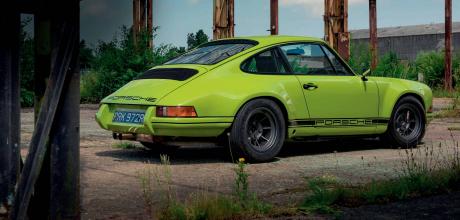ST-inspired 1977 Porsche 911 2.7 backdate
Sweet, spicy and smooth — that’s Green Chartreuse and words aptly summing up our mouth-watering 911 backdate. Join us and sip the nectar… Words Johnny Tipler. Photography Dan Sherwood.
COCKTAIL SHAKER
A superb ST-inspired 1977 Porsche 911 2.7 backdate
A subtle blend of period Porsche looks and components, this Green Chartreuse cocktail is as tasty a performer on the open road as it is in the looks department. A 911 ST lookalike, it started life as a right-hand drive 1976 impact bumper 2.7, meticulously backdated into a customised pastiche of a 1972 ST. Completely stripped back to bare metal and then methodically rebuilt over a ten-year period, the result is absolutely stunning.
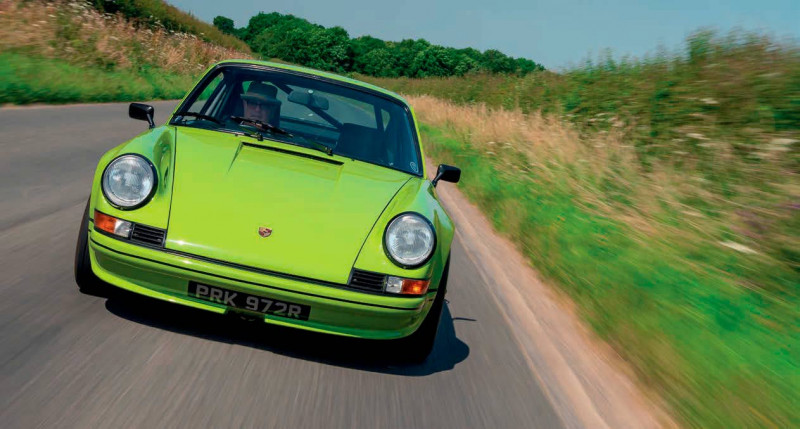
It’s the brainchild of Suffolk-based civil engineering contractor, Jeff Hall, and leading Porsche techie, Mike Roberts, and the shell evokes the racing 911 ST through the appointment of period-correct flared steel wheel arches, plus fibreglass bumpers front and rear. This was love at first sight for lifelong marque aficionado and Cromer resident, Dave Harvey, who recently bought the car from Oli Tappin, proprietor of nearby Porsche sales specialist, Bure Valley Classics.
“It’s a Jeff Hall and Mike Roberts special,” explains Oli. “It took a decade to complete, but that’s the thing about all Jeff’s creations — none of them are undertaken as a commercial project, meaning there’s no deadline to observe. He’s got various cars in-build at the same time, none built to client specification. He simply builds them for fun. With this car, he assembled it, covered a few miles and, typically, had another project waiting in the wings. Occasionally, he offers finished projects for sale, and if you dig what you see, you can make him an offer.” Enter Dave Harvey, who explains he’s been into Porsches all his life. “I established a car sales business, Performance Cars, on Walford Road in Northampton, when I was twenty-three years old, and soon bought my first 911,” he reveals. I’m sure Dave won’t mind if I tell you this was the early 1970s, halcyon days of the 911. It’s obvious why he adores the ST aesthetic. Later, he built a succession of similar businesses and developed a fancy for Italian speed machines. “I’ve got a Ferrari, but it’s too much like hard work to drive, whereas a 911 is much easier to live with, especially at my age!”
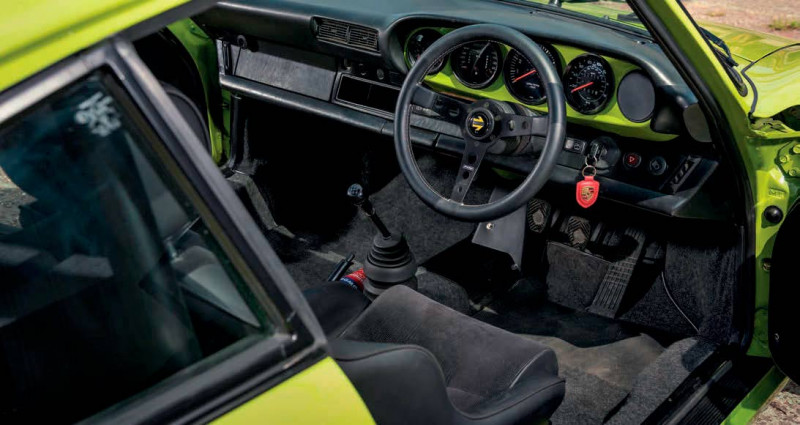
The green wide monster had a comprehensive nut and bolt rebuild expertly carried out by Mike, who’s located at Performance & Classic Cars, based at North Norfolk’s largest business centre, Scottow Enterprise Park, on the former site of RAF Coltishall. Here, he works with the company’s Managing Director, John Timewell, on a number of classic Porsche projects. As far as this brightly coloured backdate is concerned, it’s fitted with a fully sorted Carrera RS 2.7 flat-six, complete with magnesium casings, new barrels and fresh pistons. Unsurprisingly, a new clutch was fitted and there’s a CDI+ ignition unit from Classic Retrofit, a company specialising in the modern electronic upgrades for vintage Porsches. The tinware claddings are now amber in hue, and a correct 1974 Bosch mechanical fuel injection pump is installed. There’s a front-mounted oil-cooler, the exhaust system includes SSI heat exchangers and the Turbo Thomas exhaust box is gas-flowed. As for the running gear, one of the car’s most striking features is the Aurum-gilt Group 4 Wheels Campagnolo fifteen inchers (eight inches of width at the front, eleven at the back) shod with chunky Michelin TB15 rally tyres. This particular rubber is great on wet roads and is perfectly suited to historic rallies, but it’s by no means faultless — the slight downside is that when TB15s get hot, gravel sticks to the tread, scattering it around the inner wheel arches. It is, however, impressively grippy on the warm July day we’ve lucked into.
INTO THE DRINK
Suspension-wise, the rear struts have been reinforced in accordance with an Elephant Racing suspension set up, comprising Bilstein coilovers, as well as poly-bronze bushes, bearings, spacers, strut brace, spring plates, bump-steer kit and shock tower reinforcements. At the front, petrol is contained in a hundred-litre centre-fill fuel tank, while the Fuchs spare is retained by an ST-style strap. Within the cabin, we find a straightforward stripped interior, appropriate for the early 1970s competition car aesthetic. BF Torino bucket seats — finished in black leather and shrouded by Sabelt four-point harnesses — are joined by an OMP half roll-cage, a lightweight carpet set, wind-up windows and RS-style door cards with canvas pull-openers. In a further nod to supposed competition use, the gauge binnacle lacks a clock, the radio is deleted, there’s a fire-extinguisher on the passenger floor and a MOMO Prototipo steering wheel gives the car a genuine sporting feel. It’s nice to see the instrument panel finished in the same zesty green as the exterior.
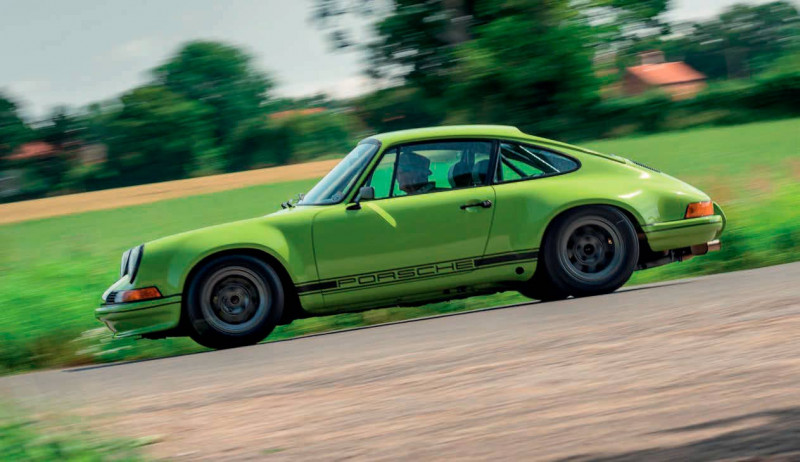
This was an expensive conversion, carried out over a long period. Surely, it’s a hot rod? Well, no, not really. In my opinion, it’s too much of a quality production to be dismissed as a backyard bruiser. Okay, then. What’s the muse behind the Chartreuse cruise? We’re in fairly esoteric territory here. If you’re already scratching your head wondering what a 911 ST actually is and how it stacks up against the more familiar RS, how about the TR? Here’s the background.
The 911 ST was descended from the 1967 911 R factory motorsport machine. The intention was to run the R in sportscar racing, but homologation rules pitched it in with prototypes. Consequently, in 1968, Porsche created the 911 TR, a 911 T chassis making use of a 911 S engine and homologated as a Group 3 GT car — still relatively modified, but less so than the R. Somewhere in the region of thirty-six TRs were built and campaigned by professional and amateur race and rally teams. For 1970 and 1971, the standard 2.2-litre S became the base model for tackling the touring car race and rally scenes. This iteration of 911 is widely identified as the ST. And while the rally cars retained standard engines, racing versions were initially increased by 52cc, accompanied by a power hike from 180bhp to 240bhp, fired by twin-plug ignition and mated with a 901 transmission and limited-slip differential. This may not sound radical compared with what came subsequently, but it was early days, and small increments made for considerable gains.
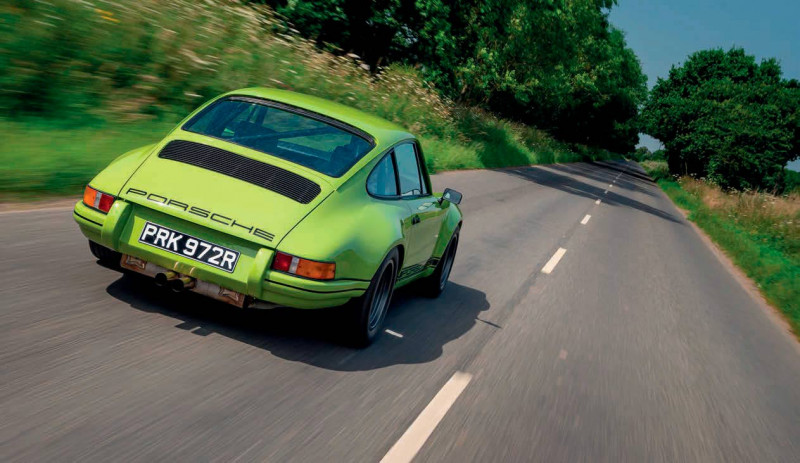
It’s likely fifteen examples of the 2.3-litre ST were built in race and rally form, with a further twenty-three units of the 2.5-litre ST designated as race cars. Like the TR, the ST designation was an in-house amalgam of existing model identifiers: an S engine and the lighter T chassis. Legend has it twenty-five ‘bodies-in-white’ (bare shells), lighter than standard, were taken off the 911 assembly line in 1969, before being sent to Weissach to be built into race cars. The first 2.3-litre STs may well have originated from these lightweight bodies. It’s also possible some of the 2.5-litre STs were built on the same. Evidently, there was far more going on with the ST than just an increase in cubic capacity. Wider wheels and tyres for enhanced grip required flared wheel arches front and rear. The solution was a delightful and fascinating mélange of materials. For example, on the early ST, the front arches were made of fibreglass and the rears from steel. The front lid and both bumper panels were assembled from fibreglass, with aluminium doors and engine lid. Apart from the front screen, all windows were polycarbonate. The rear three-quarter panels, roof and rear seat-pans were in thinner gauge steel, while all extraneous fixtures and fittings were left out, from glovebox lid and ashtray to front and rear lid locks, door and bumper trim strips. There was no sound deadening material or floor mats, and the paint was even thinned down. Apart from a competition fuel tank with central under-bonnet filler, front strut brace and brake calipers from the 908/2 prototype, the running gear was little changed. It’s a purposeful looking machine, but visually, the most obvious indicator of the ST’s identity is the difference in wheel types — since Fuchs didn’t produce nine-inch-wide rims back then, Porsche had to look elsewhere. It found what it needed at Minilite, whose eight-spoke competition wheels (ubiquitous in contemporary touring car racing) were made of sandcast magnesium and were lighter than aluminium.
RAISING THE BAR
The 24 Hours of Le Mans is a great barometer for gauging which race cars are on the scene at any particular time, and for 1970’s daylong race at Sarthe, four of the eleven 911s running were ST specification. Sadly, just one classified as a finisher (the Erwin Kremer/ Nick Koob 2,253cc car, placing seventh overall).
A special lightweight 911 S (featuring swirling psychedelic red and yellow livery) equipped with a bigger-bore-and-stroke 2,395cc flat-six was built for the 1970 Tour de France and driven to second place by Gérard Larrousse. The following year was, arguably, the ST’s heyday, when nine STs out of eighteen 911s ran at Circuit de la Sarthe. Raymond Touroul and Andre Anselme finished sixth overall and first in the GTS class.
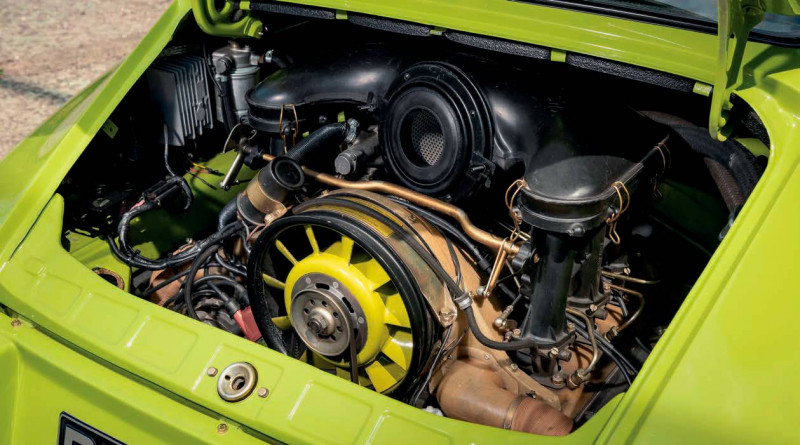
The ST’s specification shifted for 1972. Appendix J permitted only the 911 S’s fibreglass front bumper and embryonic spoiler to be used in the competition car, and ahead of the season, a number of 2.5-litre 911 S coupés were built for racing under option M491, bearing the same chassis numbering as the standard 911 S, though for this reason, it’s not easy to say exactly how many were created at the factory and how many were subsequently fettled to ST specification by private teams. Incidentally, it’s only retrospectively this group of cars has become known as ST — Porsche management discouraged doing so at the time, though it was the engineering team’s reference within Weissach. Interestingly, Jürgen Barth refers to the 1972 race cars simply as 911 S, leaving the ST back in 1970-1971, but it seems fair enough to categorise the period’s competition 911 as the ST, certainly up to the inception of the Carrera RS 2.7 in 1973.
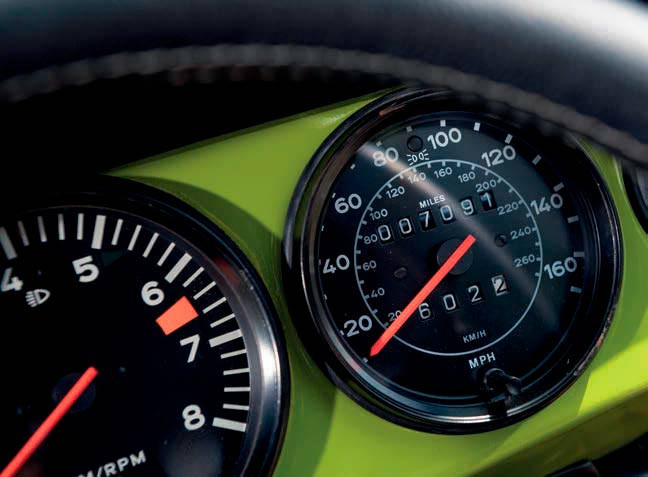
STs left the factory as race cars, although they were still usable as daily drivers. Racing 911s had yet to become too sophisticated to be used as such. The ST was followed by the RSR 2.8, essentially a race car which could be driven on the street, whereas the TR was a street car you could drive on the track. It’s difficult to identify a factory build, because it could have started as a street car and, later, be sent back to the factory for conversion. Of course, this doesn’t make it an original factory racer. These 1972 STs were fitted with bigger bore (86.7mm x 70.4mm) 2,492cc competition flat-six engines (Type 911/70) assigned a special serial number group mated with uprated gearboxes, improved cooling and full pressure lubrication. Suspension modifications included new anti-roll bars and harder Bilstein shocks, and a half roll-cage was located in the rear of the stripped-out cockpit. The suspension was lowered, seven-inch and nine-inch wheels were fitted (traditional Fuchs on the front and the aforementioned Minilites on the back) enclosed by the familiar swollen wheel arches, flared by five centimetres in accordance with regulations and fabricated in steel to a curvature peculiar to the ST. There were significant differences in composition to the earlier STs, and apart from the front spoiler, the rest of the body panels were also in steel or aluminium, including steel front wings and an aluminium valance between the deleted overriders, adding up to a given weight of 1,025kg.
Stylistically, what’s intriguing about the ST is the way the front wheel arches marry up so beautifully with the front bumper and front valance. There’s also the rather heroic swell of the rear wheel arches. In fact, the flaring of front and rear arches is one of the finest and most satisfying of all car designs, and having the classic bumpers, grilles and indicators in the wings adds to the charisma.
KNOCK IT BACK
The interior lining of the M491 cabin was black, with simplified door panelling, Recaro bucket seats, OMP four-point harnesses anchored from the rear bulkhead and a roll hoop, rather than a comprehensive cage. A smaller four-spoke steering wheel (380mm) was fitted and lightweight door linings featured thong openers and wind-up windows. The rev counter was in the conventional position, rather than being mounted upside-down. Externally, a pair of Cibie driving lamps mounted on the front lid. The racing fuel tank was filled via a central filler nozzle and STs were delivered with Weber carburettors, but could be specified with Bosch mechanical fuel injection. Racing camshafts and pistons were incorporated, engines were blueprinted with polished intake and exhaust ports, plus a dual ignition system was fitted. In this specification, the 2.5-litre engine developed an impressive 270bhp at 8,000rpm. While our Chartreuse beauty is not an exact replica of an ST, it’s close in spirit and aesthetics.
Equally, RS buffs might easily contend it owes much to the RSR 2.8, the racer which evolved almost overnight from the Carrera RS 2.7. Conceived in 1973 to contest the international Sports Racing category, where it was hoped it would be quick enough to go head-to-head with the Ferrari and Matra prototypes, the RSR 2.8 was a quantum leap from the Carrera RS 2.7, embodying the transition from 911 GTS racers to the more extreme Group 5 934, 935 and ‘Experimental’ 930 turbocharged specifications which entered the fray in 1976. The suffix RSR stood for Renn Sport Rennen, translated into English as Motor Sport Racer. Porsche needed to build fifty units of the RS for homologation, meaning the RSR had a legitimate basis and forty-nine copies were manufactured. The original 2,808cc RSR, complete with stripped-out cabin and built-in roll-cage, weighed 900kg and delivered 300bhp at 8,000rpm. It boasted high-compression pistons, twin-plug ignition, a bigger fuel injection pump, wider wheels, fatter tyres and flared wheel arches. For 1974, the RSR made use of 917 brakes and a stronger aluminium crankcase, bigger barrels and pistons, taking it up to three litres of displacement and 315bhp, plus slide-valve fuel injection. Wheel and tyre width broadened to ten-and-a-half inches at the front and fourteen at the rear, accommodated by steroid-bulging fibreglass wheel arches with air vents slashed in the trailing edges of the front wings and ahead of the rear wheel arches. It was fronted by an air-dam with integral oil radiator, as well as a pair of air ducts, and finished with a whale-tail rear wing. The factory used several cars as aerodynamic mules in preparation for the launch of the three-litre 934 and slant-nose 2.8-litre 935 turbo cars.
HAIR OF THE DOG
Although initially vulnerable to failing driveshaft joints, the RSR (in three-litre guise) was good enough to claim seventh place overall at the 1974 24 Hours of Le Mans, with several other high placings. John Fitzpatrick took the European GT Championship, as well as five wins in the World Championship GT category events that year, piloting George Loos’ RSR 3.0. Best result for the RSR at an international level in 1975 was the 24 Hours of Daytona, where Peter Gregg and Hurley Haywood headed five more RSRs for outright victory. Their Brumos RSR won the US IMSA title three years running, from 1973 to 1975. At Le Mans in 1975, the best finish for an RSR was fifth place (John Fitzpatrick and Gijs Van Lennep) when no fewer than fourteen RSRs took part. And this is the chronicle of inspirational iconography in which our Chartreuse cocktail is lodged in the depths of.
Enough of the gloating — let’s get this show on the road! I get Dave to drive out of the village, and we swap positions. Pop the seat back a tad, get those harness straps over the shoulders and around the crotch. Like all classic right-hand-drive 911s, we have the slightly offsetleft pedal situation, but once you’re up and running, you don’t notice it. There’s a raw, energetic honesty about this car elevating from your average backdate. It sounds gorgeous from the off, and it’s revelling in the revving, typical of MFI engines, where 4,500rpm seems a prudent shift point. You know straightaway this car has been put together really beautifully. It hauls perfectly agreeably in each gear and the brakes are good, too — you stand on them more than you would in a modern car, but they work fine. This Porsche feels absolutely perfect, certainly in terms of steering, throttle control, gear shift. It’s as alluring and rewarding to drive as it is to look at. It’s like an enthusiastic, but more raw Carrera RS 2.7 and it slingshots me down a nearby straight, writhing under hard braking and twitching at the slightest hump, its nose exploring every nuance of these rural roads. It could be a hectic ride, but I find optimum control comes by relaxing and simply being the guide rather than the hustler — the steering is light, requiring a deft touch rather than brute force, and lock isn’t bad, considering tyre width. This 911 is beautifully configured and easily controllable, tracking beautifully, and with pinpoint turn-in on these tight Norfolk B-road bends, allowing me to place the nose exactly where I want.
This Porsche responds eagerly as I ease on the gas pedal, surging from corner to corner in a glorious six-pot shriek, a sheer aural delight up around 5,000-6,000rpm, where I’m using third and fourth gears, dropping down to second for the corners, blipping the throttle as I double-declutch. It’s relatively softly sprung, though controlled and firm as I pitch it through a familiar set of undulating woodland corners — the closet snatch of Nordschleife I can conjure up in this part of north Norfolk. There’s a thought: this kiddie would have a ball at a Nürburgring track day, but if I want another go, owner Dave lives a stone’s throw from where I reside — I bet I can lure him out with it on the promise of beer, if not, a cocktail!
Below Perfect for hard driving along North Norfolk’s backroads, this stunning ST evocation will be put through its paces by its new owner. Above 2.7-litre flat-six was thoroughly rebuilt and upgraded during the ten-year restoration process. Below Spare wheel is a Fuchs held in place by an ST-style leather retaining strap.
THE FLARING OF FRONT AND REAR ARCHES IS ONE OF THE MOST SATISFYING OF ALL CAR DESIGNS
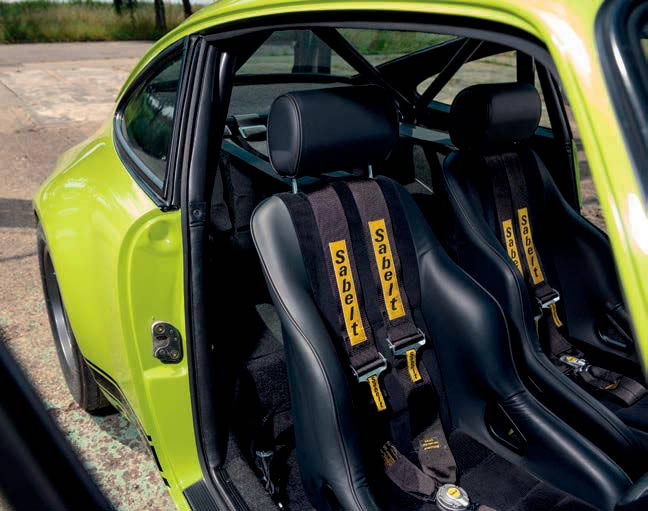
Above and facing page BF buckets can be awkward to slide in and out of, but they’re super-comfortable and hold occupants firmly in place when the car is being pushed hard around corners.
Above Mean, green and sounding obscene, this superb backdate started life as a 1976 911 2.7, complete with impact bumpers.


